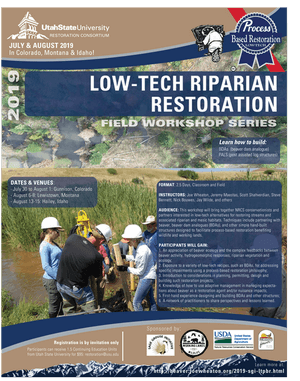2019 Field Workshop Series
Overview
Thanks to the generous support of the Natural Resources Conservation Service's Working Lands for Wildlife Initiative and the Sage Grouse Initiative, along with a grant through Pheasants Forever to Utah State University's Restoration Consortium and Joe Wheaton's ET-AL lab, this workshop series delivered field-based training across the West.
This series was envisioned by Jeremy Maestas (NRCS/SGI) and was made possible thanks to partner matches by local organizations in each state, and support from Utah State University. The series builds on earlier efforts including the 2016 Enhancing Mesic Habitat Resilience Workshop and the 2018 series.
Three Workshops, Three Western States
In Summer 2019, workshops were held to connect NRCS conservationists and partners interested in low-tech process-based riparian restoration:
-
Colorado Workshop
July 30 – August 1, 2019, Gunnison, Colorado
More Info -
Montana Workshop
August 6 – 8, 2019, Lewistown, Montana
More Info -
Idaho Workshop
August 13 – 15, 2019, Hailey, Idaho
More Info
Course Materials
Slides & Handouts
Workshop Textbooks
Workshops relied on these core resources:
-
Low-Tech Process-Based Restoration of Riverscapes: Design Manual
Wheaton J.M., Bennett S.N., Bouwes, N., Maestas J.D., Shahverdian S.M. (Editors). 2019.
Utah State University Restoration Consortium. Logan, UT. 286 pp.
DOI: 10.13140/RG.2.2.19590.63049/2 -
Low-Tech Process-Based Restoration of Riverscapes: Pocket Field Guide
Wheaton JM, Wheaton A, Maestas J, Bennett S, Bouwes N, Shahverdian S, Camp R, Jordan C, Macfarlane W, Portugal E, Weber N. 2019.
Utah State University Restoration Consortium.
DOI: 10.13140/RG.2.2.28222.13123/1
Free digital copies were provided to participants; hard copies are also available on Amazon or BookBaby.
More Background
Through SGI 2.0, NRCS has committed to working with landowners and partners to protect and restore mesic habitats like riparian areas and wet meadows to benefit sage-grouse.
Beaver Dam Analogues (BDAs) have emerged as a low-cost, nature-inspired technique to mimic beaver activity and restore hydrologic and ecological processes in degraded channels. BDAs and other simple structures can promote riparian resilience at scales meaningful to working lands and wildlife.
The workshop series was designed to bring together interdisciplinary staff to evaluate these low-cost, low-risk practices, examine restoration opportunities, and learn how to implement them to meet mesic habitat goals.
Instruction Team
- Mark Beardsley — Ecologist
- Stephen N. Bennett — Ecologist, Adjunct Professor
- Nicolaas Bouwes — Aquatic Ecologist, Adjunct Professor
- Jeremy Maestas — Ecologist
- Scott Shahverdian — Fluvial Geomorphologist
- Nick Weber — Fish Ecologist
- Joseph Wheaton — Associate Professor, Ecogeomorphologist
- Jay Wilde — Rancher and Land Owner
Instructor Affiliations
Audience
This workshop series was intended for NRCS staff and key partners. NRCS states selected representatives engaged in mesic restoration, including biologists, engineers, and local specialists. States could also invite local partners supporting on-the-ground mesic conservation.
Participation was invitation-only, with a cap of about 45 participants per workshop to keep hands-on activities effective. Participants could optionally earn 1.5 Continuing Education Units from Utah State University for $95.
Make It Count
Participation was free by invitation, with CEUs available for a fee.
Utah State University Restoration Consortium
